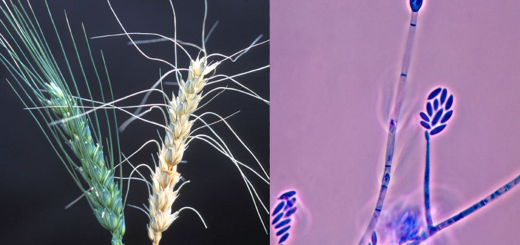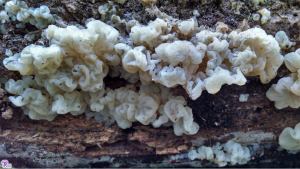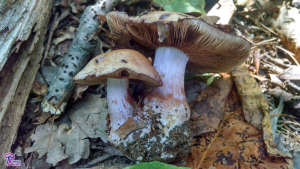#076: Orchid Mycorrhizae
Orchid seeds do not contain sugars, so the seeds take sugars from a mycorrhizal fungus. All orchids are parasitic on fungi while they are seedlings. Because of this unusual relationship, orchids form unique mycorrhizae that differ from both ecto- and arbuscular mycorrhizae.
The family Orchidaceae is one of the largest plant families. With well over 20,000 described species (and an even greater number of hybrids), the diversity of the Orchidaceae is truly remarkable. Orchids can be found in the desert, the tundra, the tropics, and temperate regions. What’s more, they have developed a number of different methods of pollination. Some species attract pollinators with bright colors, others with smells (pleasant, fetid, etc.), and others by looking like female insects. Many orchids rely exclusively on one species of pollinator, giving rise to unique species relationships. Orchids have also been successful in the horticultural industry. Showy, tropical orchids are popular gifts to express a variety of relationships. Perhaps you’ve bought an orchid for someone in preparation for tomorrow’s celebration of Valentine’s Day.
One of the more unusual things about orchids is that their seeds contain almost no sugars or nutrients. Orchid seeds are extremely small, weighing around only 0.3 to 14 micrograms. Because of the small size, each flower can produce millions of seeds. These “dust seeds” take in water once they land in a suitable environment, which causes the cells to expand and rupture the seed coat. The seedlings then use what little resources they have to produce small root hairs. At this point, the seedlings require an external source of carbon in order to grow. The orchids obtain this excess carbon by forming mycorrhizae with various fungi. Since the orchid does not have any of its own resources, it takes sugars and nutrients from the fungus without giving anything back. Therefore, the seedling is technically parasitic on the fungus (“mycoheterotrophic”*). The seedlings use these nutrients to grow roots and the beginnings of a stem.
What I have described above is the best possible outcome for the seedling, but two other things can take place after the seed coat breaks open. In the first case, the orchid may fail to form mycorrhizae. Another possible outcome is that mycorrhizae are formed, but the fungus parasitizes the seedling. In both of these cases, the seedling receives no nutrients from the fungus and quickly dies. All three possible outcomes can happen in the same batch of seeds with the same fungus, which demonstrates how difficult it is to maintain the mycorrhizal balancing act. Thankfully, the large number of seeds that orchids produce make up for the fact that some seeds will inevitably die.
Most orchids eventually develop leaves and produce their own nutrients, but some remain mycoheterotrophic throughout their life and do not need to produce leaves. Some of the photosynthetic orchids only develop leaves after a growing as a root system for a few years and are thus totally reliant on fungal symbionts for a good portion of their life. All orchids maintain mycorrhizae, even as adults, but the precise role of mycorrhizae in photosynthetic orchids remains unclear. The fungus does not seem to benefit from orchid mycorrhizae, but it has not yet been established whether or not adult photosynthetic orchids continue to get nutrients from their mycorrhizal partners.
The fungi involved in orchid mycorrhizae are usually basidiomycetes and perform a variety of ecological roles. Orchid mycorrhizal fungi can be saprobic on organic matter, parasitic on living plants, or ectomycorrhizal. Photosynthetic orchids tend to have a wide array of possible fungal hosts, while mycoheterotrophic orchids tend to require a very specific host. In the case of photosynthetic orchids, each orchid may form mycorrhizae with multiple species of fingi. The more finicky mycoheterotrophic orchids usually pick ectomycorrhizal fungi as partners. In this case, the orchid indirectly gets its carbon from a nearby tree via the mycorrhizal network. Many fungi found in orchid mycorrhizae are placed in the genus Rhizoctonia, but this genus is based on their asexual morphology. As the sexual stages of Rhizoctonia species have been discovered, the fungi are taken out of this genus and placed in a genus containing their true close relatives. Through this slow but methodical process, it has become clear that orchid mycorrhizae can be formed with a wide diversity of basidiomycetes.
Orchid mycorrhizae form unique structures. These structures are all the same, despite the fact that some host fungi are normally ectomycorrhizal while others are normally nonmycorrhizal. In every case, the fungus grows into the seedling (or roots or stem, if the orchid is older) and penetrates the cell wall, but not the cell membrane. Instead, the orchid’s cell membrane fits around the fungus’s cell wall like a glove. Once inside the cell, the fungus forms a structure called a peloton. Pelotons consist of dense coils of fungal hyphae that fill the cell. As with other mycorrhizal structures, pelotons serve to increase the surface area available for nutrient exchange. Pelotons are short-lived structures and most last for only a few days. At the end of this time, the orchid cell dissolves the fungal cells and consumes their nutrients. Unlike other types of mycorrhizae, the orchid cell is then free to form another mycorrhiza. Fungal hyphae proliferate inside the orchid by growing directly from one cell to the next. For those of you who have been keeping up with Fungus Fact Friday, you may think this sounds very similar to arbuscular mycorrhizae. However, all fungi involved in orchid mycorrhizae are from the phylum Basidiomycota instead of the phylum Glomeromycota (which form arbuscular mycorrhizae). This indicates that the orchid is in control of the mycorrhizae and is perhaps coercing the fungus into forming structures that it doesn’t want to.
Orchids’ reliance on mycorrhizae coupled with difficulties artificially pollinating the flowers initially made orchids extremely difficult to cultivate. Eventually, botanists figured out that they could get orchid seeds to germinate by giving them trehalose, which is the type of sugar used by fungi. With this external supply of carbon, cultivated orchids can be grown without any mycorrhizal partners. This has given rise to a substantial market for orchids, along with a large following of hobbyists. The rarity of certain orchids has also resulted in a number of movie/TV appearances for the fancy flowers. Orchids are also responsible for the spice vanilla, which is extracted from the “beans” of Vanilla spp. Although we normally think of orchids as tropical species, they can be found in the woods of North America. The website uswildflowers.com lists ten species of orchid that can be found in Virginia. Some orchid species maintain leaves throughout the winter, so keep an eye out for these unique plants on your next hike!
* mycoheterotrophic is easily understood if you consider its three parts separately: “myco-” means fungus, “hetero-” means other, and “-trophic” means food/feeding. Heterotrophic, then, means “feeding on others.” Biologists use this term to refer to organisms that cannot produce their own food. The “myco-” at the beginning of the word indicates that the heterotroph in question gets its nutrients from fungi.
See Further:
http://www.davidmoore.org.uk/assets/mostly_mycology/diane_howarth/orchid.htm
http://www.esf.edu/efb/horton/Orchid%20Mycorrhizae%202010.pdf
http://uswildflowers.com/wfquery.php?Family=Orchidaceae&State=VA (explore the site to find a list of orchids in your state!)








![#011: Characteristics of Kingdom Fungi [Archived]](https://www.fungusfactfriday.com/wp-content/themes/hueman/assets/front/img/thumb-small-empty.png)


